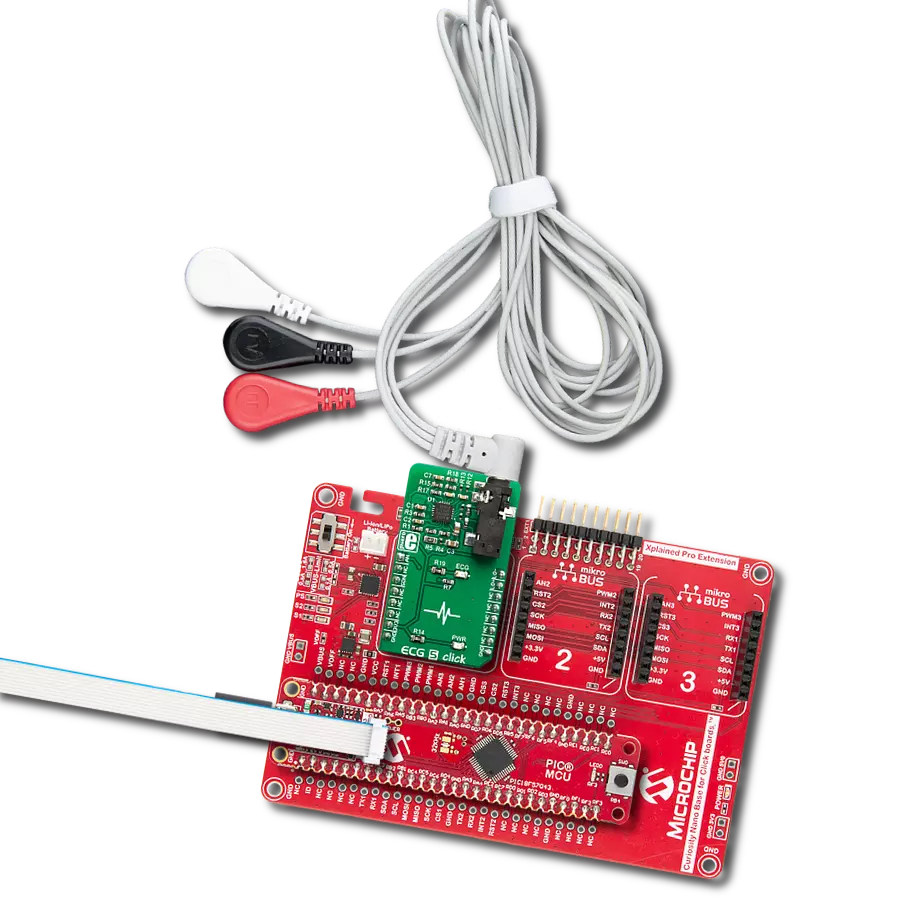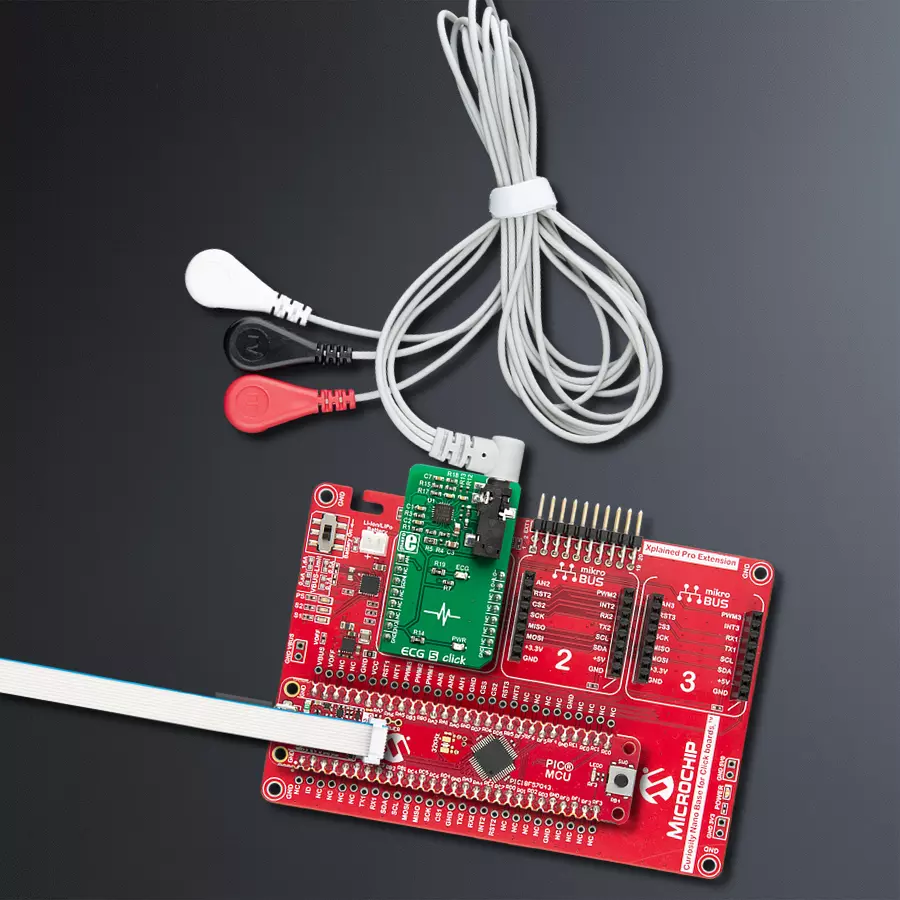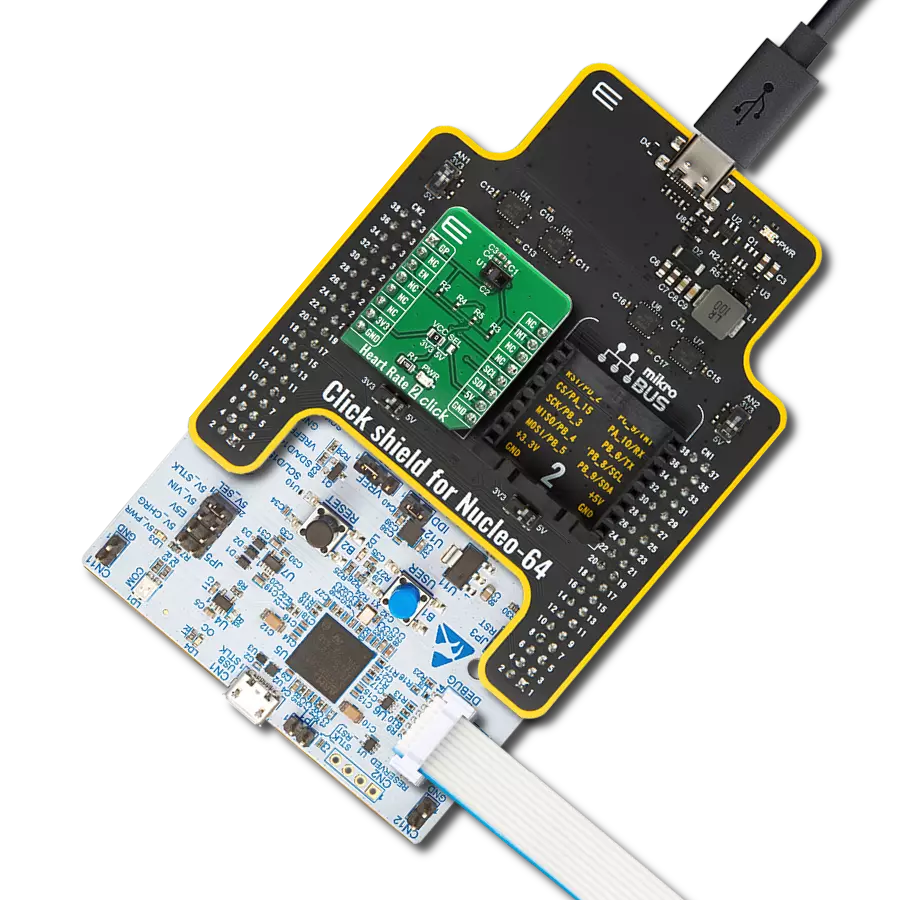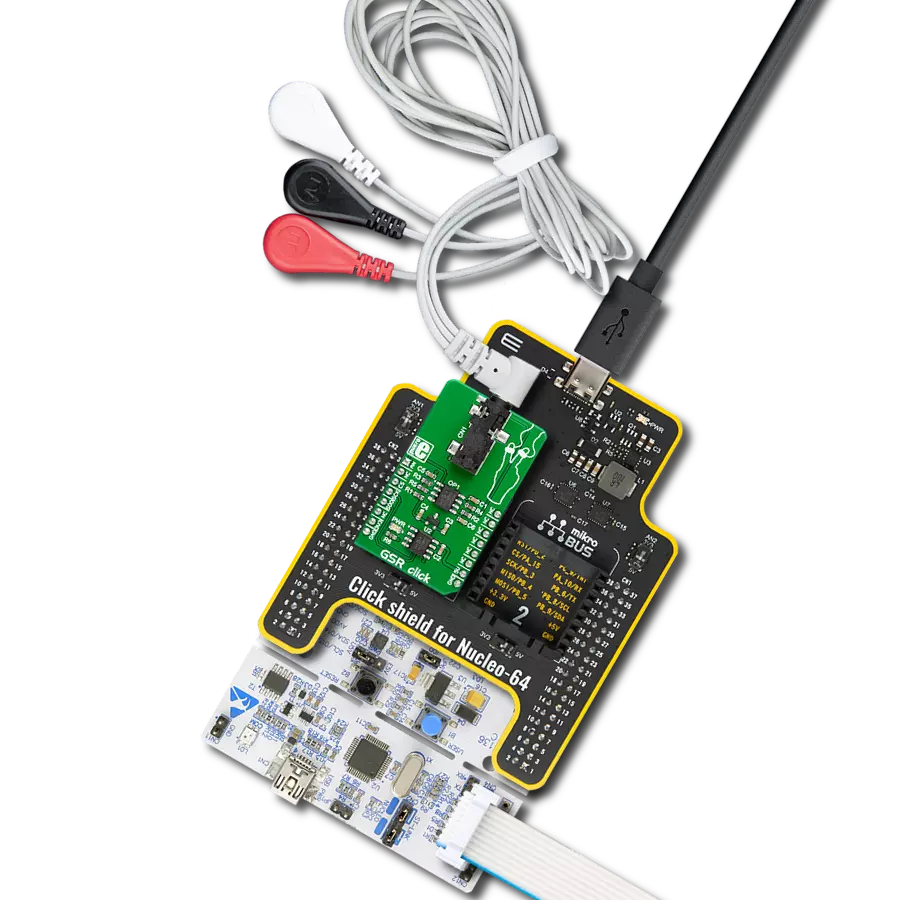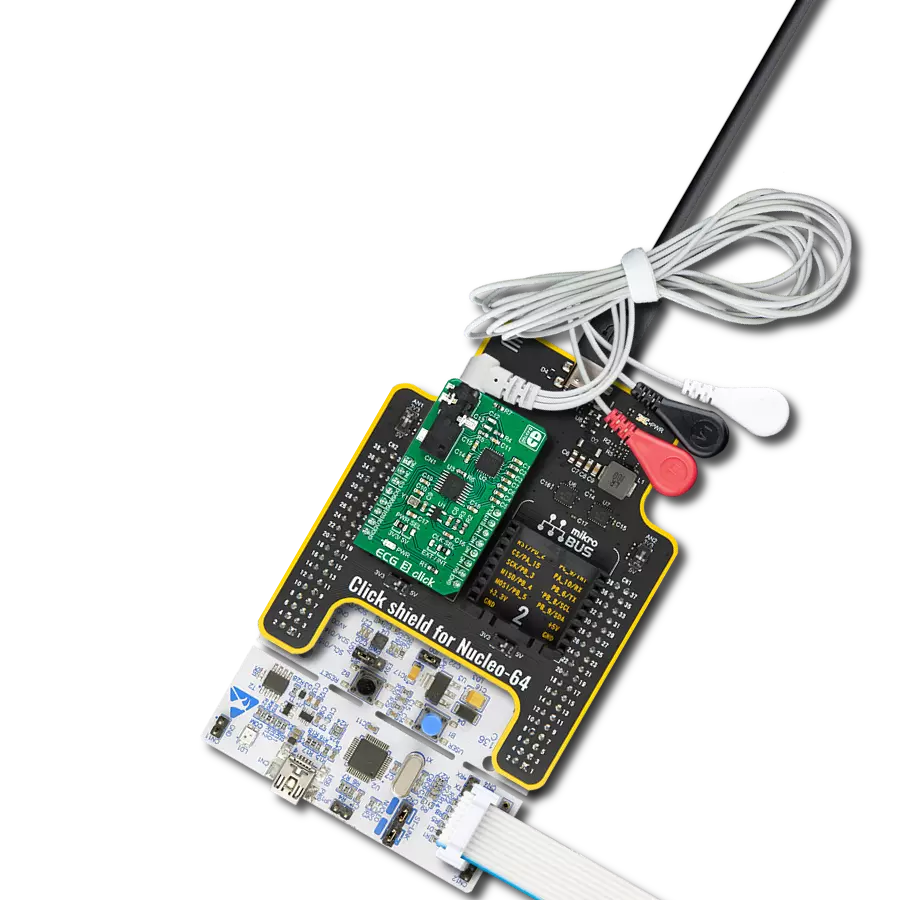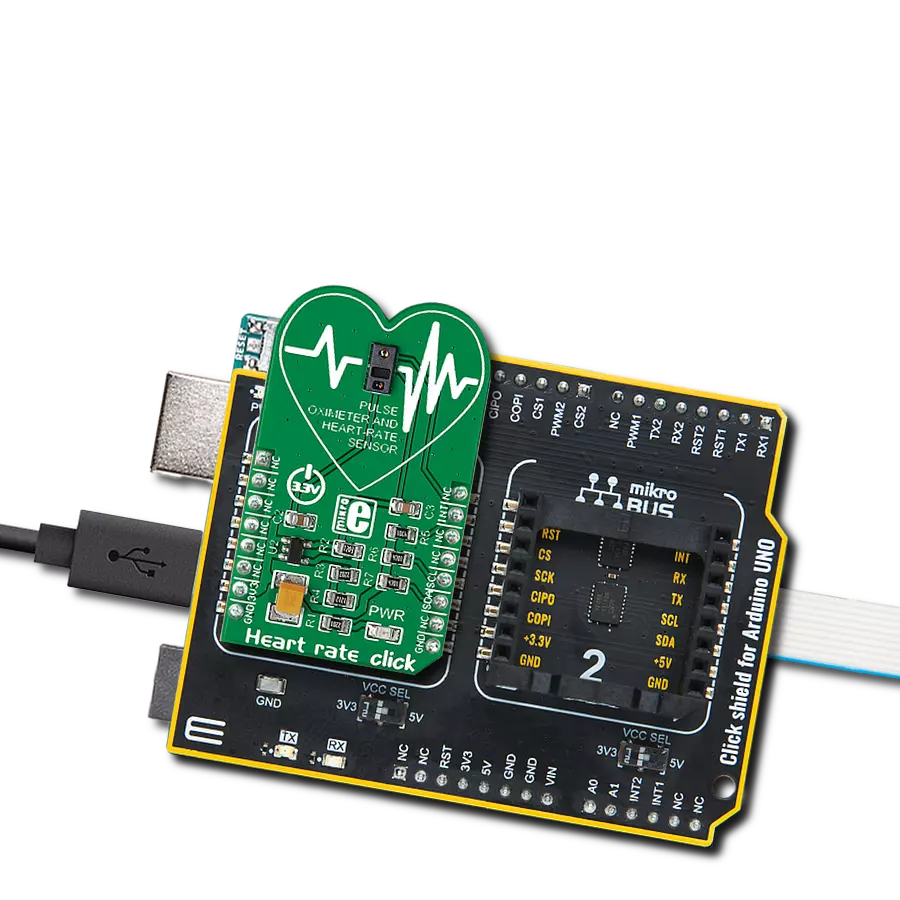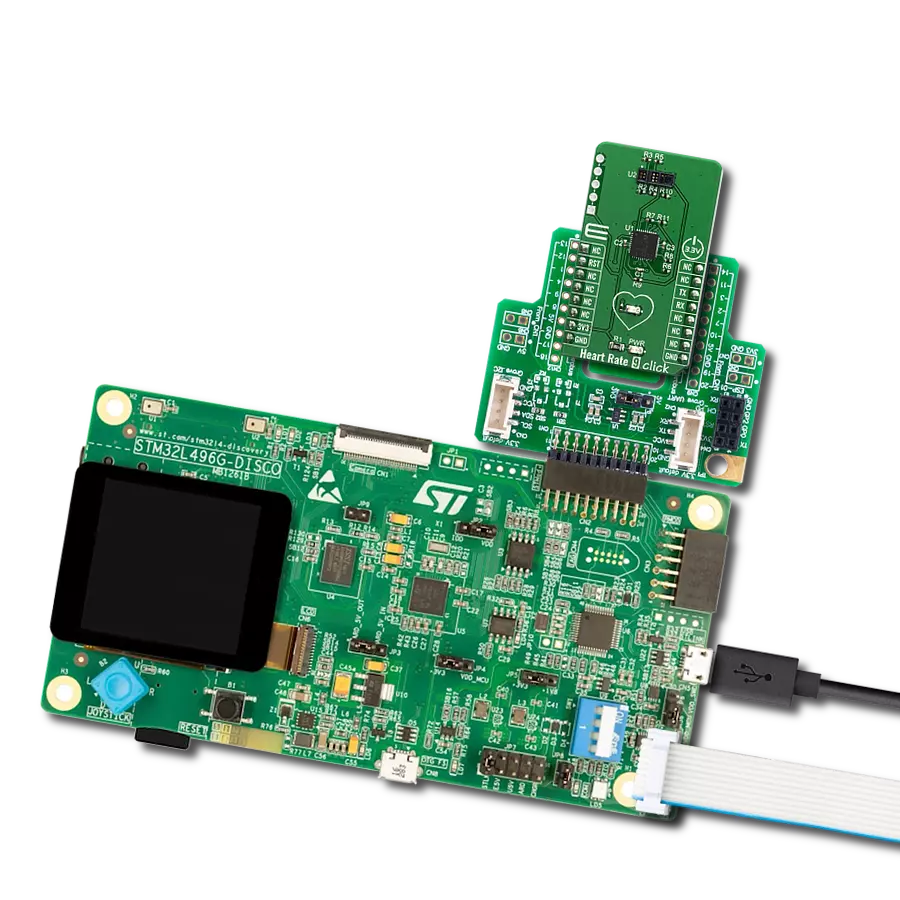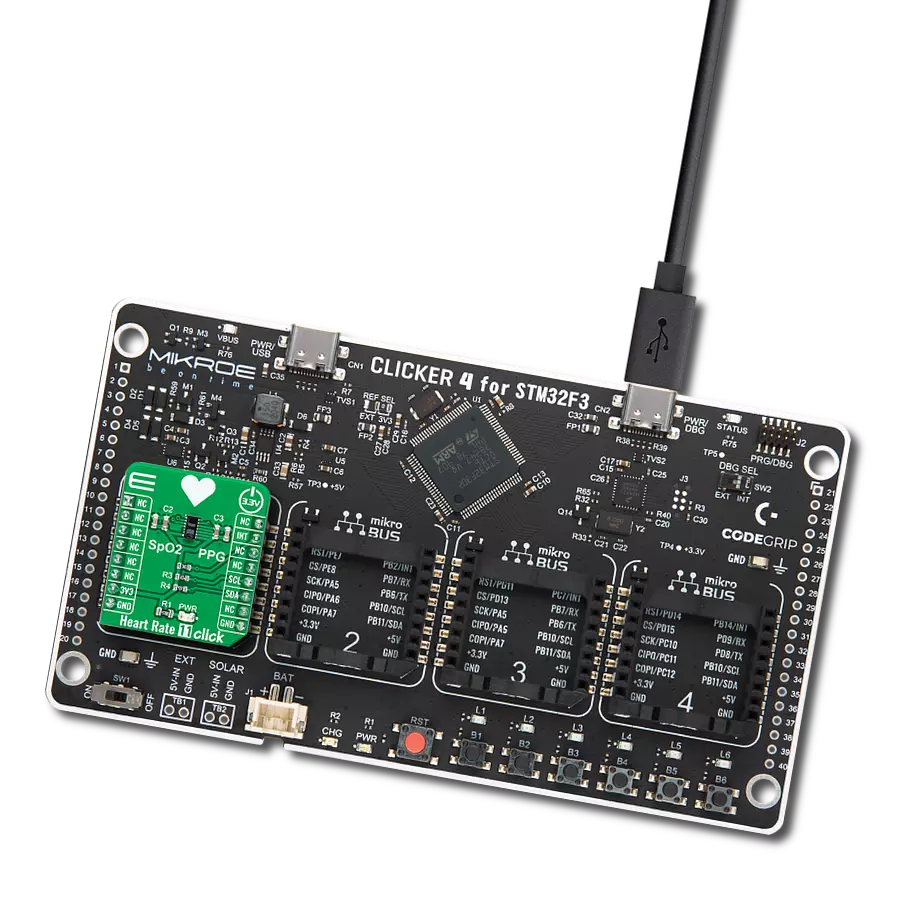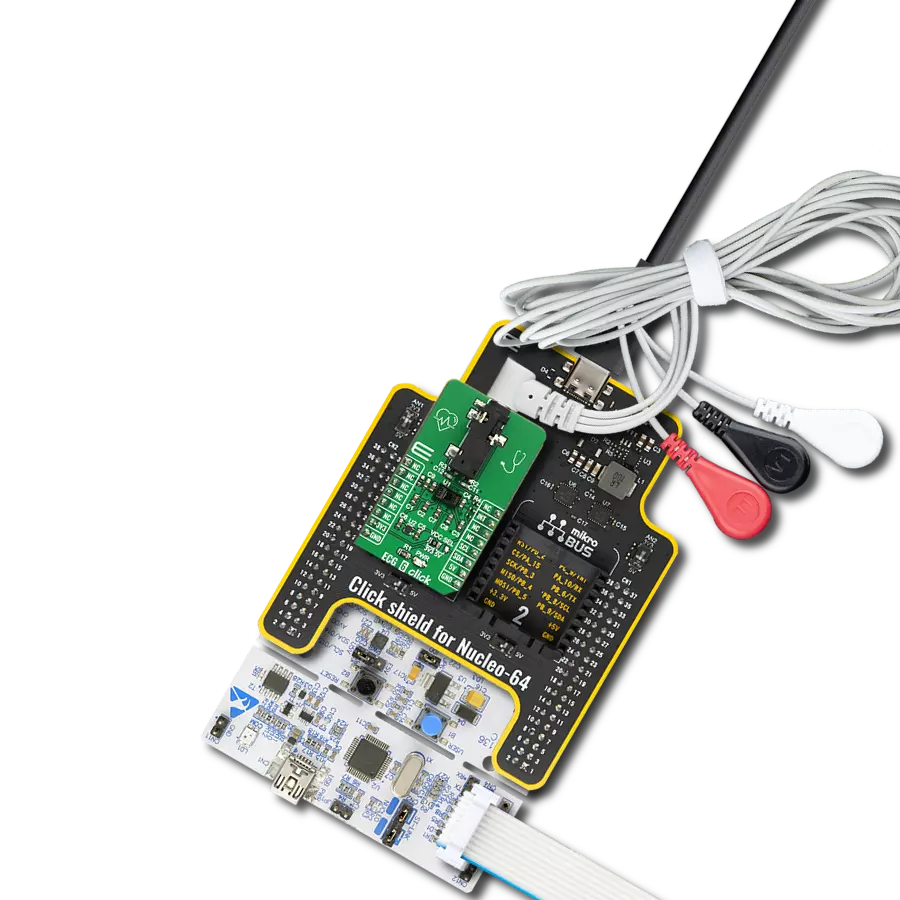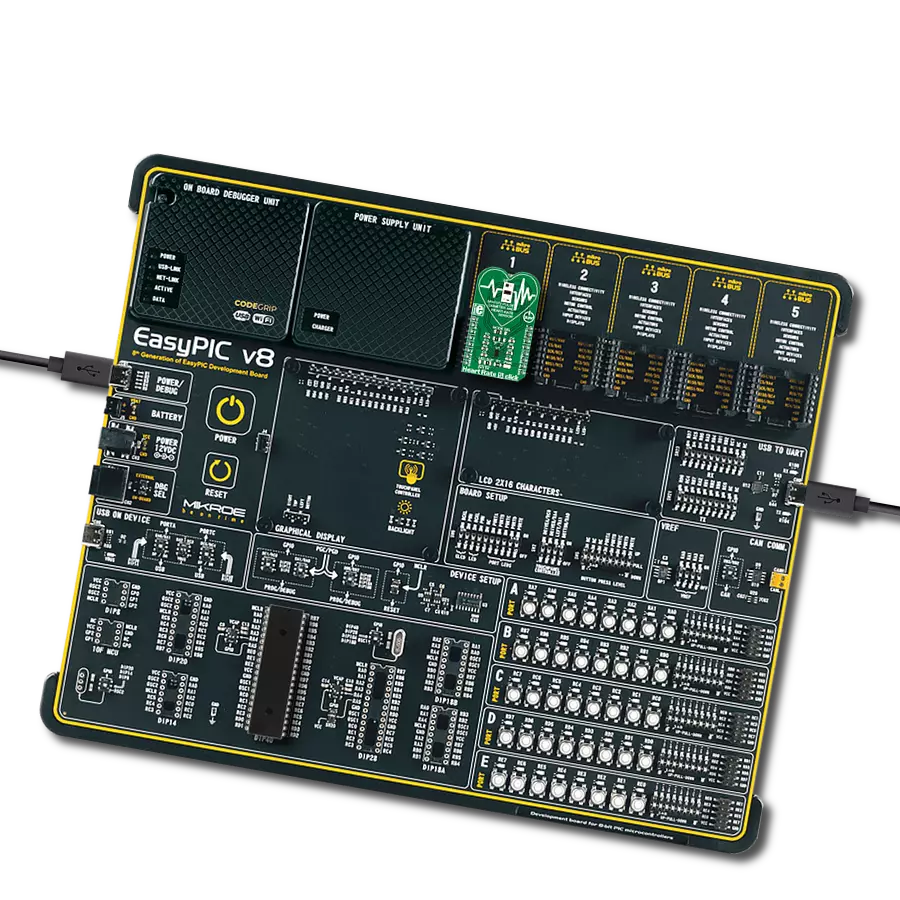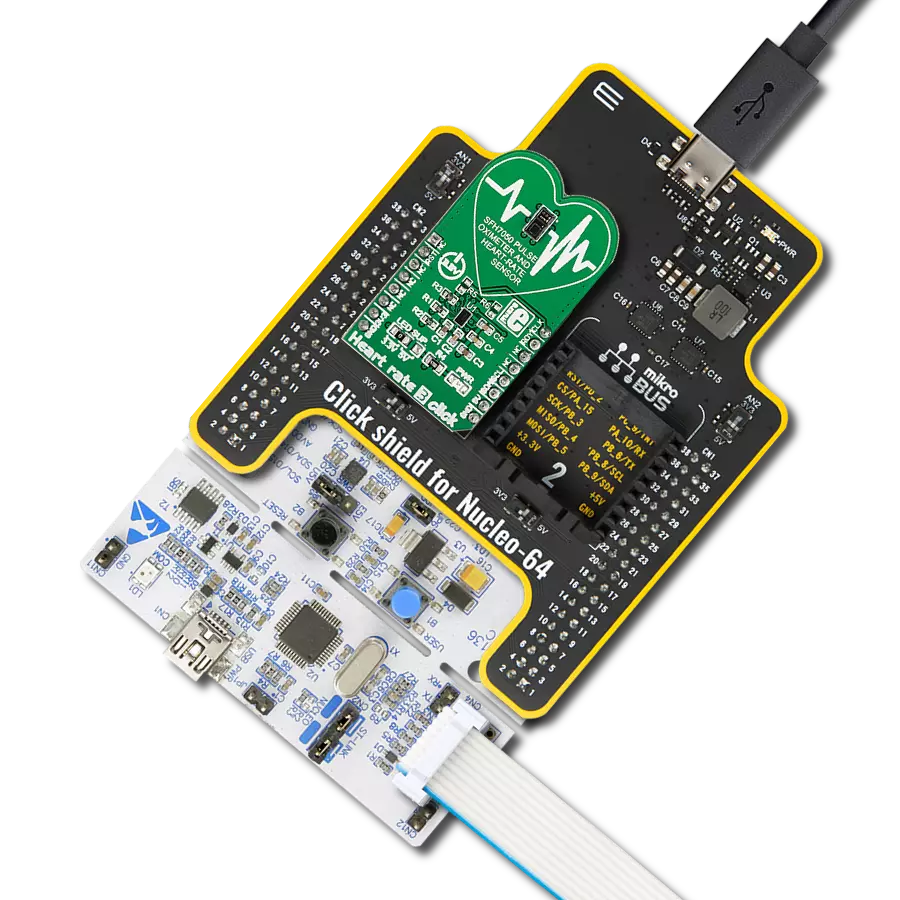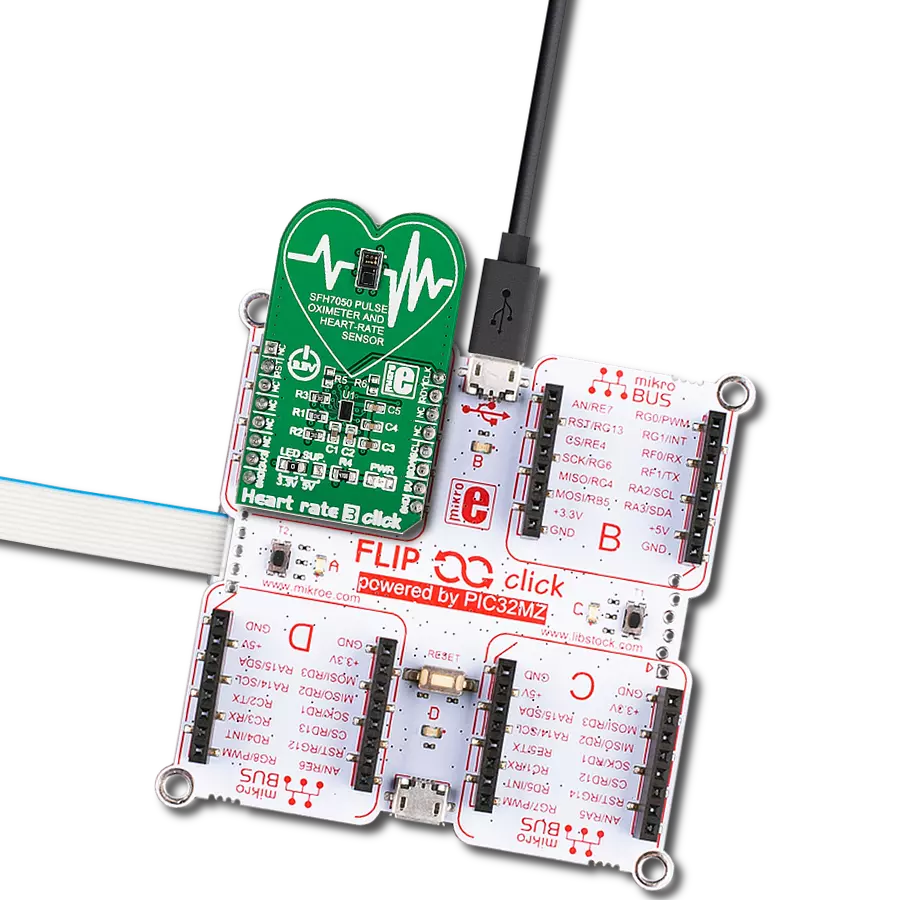The perfect solution for athletes and fitness enthusiasts, providing advanced monitoring and analysis of heart rate variability during exercise
A
A
Hardware Overview
How does it work?
ECG 5 Click is based on the AD8232, an integrated heart rate monitoring front-end, by Analog Devices. This IC is targeted toward wearables and battery-operated applications. The heart-rate impulses are naturally weak and in the range of just a few millivolts, even microvolts. Therefore, any external interference might obscure them. The interferences might be induced in the human body itself, or they might appear as the result of the activity of other muscles, such as skeletal muscles. Therefore, the input signal from the electrodes is processed by several filtering sections until it is amplified to a value suitable for sampling. However, the correct placement of the measurement electrodes is crucial for accurate readings. ECG 5 Click features a 3.5mm jack connector connecting three electrodes. One of the electrodes is a so-called right leg drive electrode (RLD), used to set the patient's body to the same potential as the rest of the system. In addition, it is used to reduce the noise resulting from the human body acting as an antenna (picking up
50/60Hz hum from the mains). Along with the integrated 2-pole high-pass and RFI filtering sections, the IC effectively reduces the overall system noise. Lead-off detection is very important for accurate ECG measurements. Therefore, this IC is equipped with the dedicated LOD pin, set to a HIGH logic level when any of the electrodes is missing. Lead-off circuitry is a comparator that ensures the body stays within 0.5V from the positive rail. By featuring two separate LOD pins, it is possible to determine the exact electrode that may be missing. In DC lead-off detection mode, all three electrodes must be connected. The LOD+ is routed to the mikroBUS™ INT pin, while the LOD- is routed to the mikroBUS™ PWM pin. The pins are labeled as LO+ and LO- respectively, on this Click board™. Due to the signal filtering within the AD8232 IC, the settling time for the connected electrodes may be too long. Therefore this IC features the fast restore option (FR pin is pulled to a HIGH logic level on ECG 5 click), which dynamically sets the cutoff frequency
to a higher value, speeding up the settling time, which may be in the magnitude of several seconds (for example, when the electrodes are connected). The IC can be driven to a low power consumption mode. If the SDN pin is pulled to a LOW logic level, the IC will enter the standby mode, greatly reducing the power consumption. Utilizing the LOD pins, the MCU can be programmed to enter the standby mode along with the AD8232, which is ideal for battery-powered applications. SDN pin is routed to the mikroBUS™ CS pin and is labeled as SDN. The OUT pin of the AD8232 is routed to the AN pin of the mikroBUS™. It provides the amplified and filtered signal from the electrodes, which can be used directly on the A/D peripheral of the host MCU. The AD8232 can drive both resistive and capacitive loads, so no additional buffering IC is required. In addition, ECG 5 click is equipped with a LED labeled as ECG, which can be used as a visual indicator of the output signal.
Features overview
Development board
PIC18F57Q43 Curiosity Nano evaluation kit is a cutting-edge hardware platform designed to evaluate microcontrollers within the PIC18-Q43 family. Central to its design is the inclusion of the powerful PIC18F57Q43 microcontroller (MCU), offering advanced functionalities and robust performance. Key features of this evaluation kit include a yellow user LED and a responsive
mechanical user switch, providing seamless interaction and testing. The provision for a 32.768kHz crystal footprint ensures precision timing capabilities. With an onboard debugger boasting a green power and status LED, programming and debugging become intuitive and efficient. Further enhancing its utility is the Virtual serial port (CDC) and a debug GPIO channel (DGI
GPIO), offering extensive connectivity options. Powered via USB, this kit boasts an adjustable target voltage feature facilitated by the MIC5353 LDO regulator, ensuring stable operation with an output voltage ranging from 1.8V to 5.1V, with a maximum output current of 500mA, subject to ambient temperature and voltage constraints.
Microcontroller Overview
MCU Card / MCU
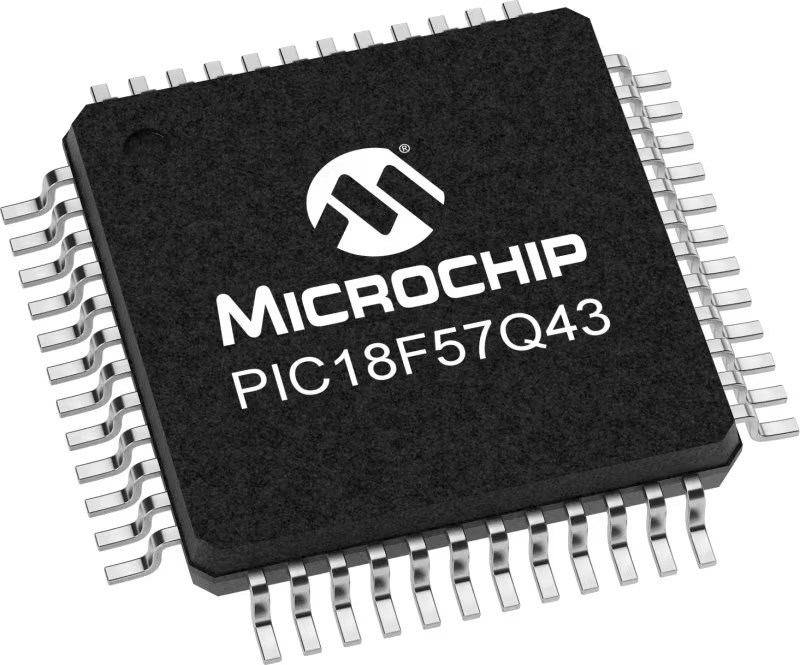
Architecture
PIC
MCU Memory (KB)
128
Silicon Vendor
Microchip
Pin count
48
RAM (Bytes)
8196
You complete me!
Accessories
Curiosity Nano Base for Click boards is a versatile hardware extension platform created to streamline the integration between Curiosity Nano kits and extension boards, tailored explicitly for the mikroBUS™-standardized Click boards and Xplained Pro extension boards. This innovative base board (shield) offers seamless connectivity and expansion possibilities, simplifying experimentation and development. Key features include USB power compatibility from the Curiosity Nano kit, alongside an alternative external power input option for enhanced flexibility. The onboard Li-Ion/LiPo charger and management circuit ensure smooth operation for battery-powered applications, simplifying usage and management. Moreover, the base incorporates a fixed 3.3V PSU dedicated to target and mikroBUS™ power rails, alongside a fixed 5.0V boost converter catering to 5V power rails of mikroBUS™ sockets, providing stable power delivery for various connected devices.
3-wire ECG/EMG cable comes with a convenient 3.5mm phone jack, and it is designed for electrocardiogram recording. This 1m cable is a practical companion for medical professionals and enthusiasts. To complement this cable, you can also use single-use adhesive ECG/EMG electrodes measuring 48x34mm, each equipped with an ECG/EMG cable stud adapter. These electrodes ensure a seamless experience when paired with our ECG/EMG cable and guarantee reliable ECG/EMG signal transmission for comprehensive cardiac monitoring. Trust in the accuracy and convenience of this setup to effortlessly record electrocardiograms and electromyograms with confidence.
Used MCU Pins
mikroBUS™ mapper
Take a closer look
Click board™ Schematic

Step by step
Project assembly
Track your results in real time
Application Output
1. Application Output - In Debug mode, the 'Application Output' window enables real-time data monitoring, offering direct insight into execution results. Ensure proper data display by configuring the environment correctly using the provided tutorial.

2. UART Terminal - Use the UART Terminal to monitor data transmission via a USB to UART converter, allowing direct communication between the Click board™ and your development system. Configure the baud rate and other serial settings according to your project's requirements to ensure proper functionality. For step-by-step setup instructions, refer to the provided tutorial.

3. Plot Output - The Plot feature offers a powerful way to visualize real-time sensor data, enabling trend analysis, debugging, and comparison of multiple data points. To set it up correctly, follow the provided tutorial, which includes a step-by-step example of using the Plot feature to display Click board™ readings. To use the Plot feature in your code, use the function: plot(*insert_graph_name*, variable_name);. This is a general format, and it is up to the user to replace 'insert_graph_name' with the actual graph name and 'variable_name' with the parameter to be displayed.

Software Support
Library Description
This library contains API for ECG 5 Click driver.
Key functions:
ecg5_setMode- Mode Setting functionecg5_check_LOD_negative- LOD- Checking functionecg5_check_lod_positive- LOD+ Checking function
Open Source
Code example
The complete application code and a ready-to-use project are available through the NECTO Studio Package Manager for direct installation in the NECTO Studio. The application code can also be found on the MIKROE GitHub account.
/*!
* @file main.c
* @brief ECG 5 Click Example.
*
* # Description
* This is an example which demonstrates the use of ECG 5 Click board.
*
* The demo application is composed of two sections :
*
* ## Application Init
* Initializes ADC and GPIO.
*
* ## Application Task
* Reads ADC value and sends results on serial plotter every 5 ms.
*
* @author Stefan Ilic
*
*/
#include "board.h"
#include "log.h"
#include "ecg5.h"
static ecg5_t ecg5; /**< ECG 5 Click driver object. */
static log_t logger; /**< Logger object. */
static uint32_t time;
void application_init ( void ) {
log_cfg_t log_cfg; /**< Logger config object. */
ecg5_cfg_t ecg5_cfg; /**< Click config object. */
/**
* Logger initialization.
* Default baud rate: 115200
* Default log level: LOG_LEVEL_DEBUG
* @note If USB_UART_RX and USB_UART_TX
* are defined as HAL_PIN_NC, you will
* need to define them manually for log to work.
* See @b LOG_MAP_USB_UART macro definition for detailed explanation.
*/
LOG_MAP_USB_UART( log_cfg );
log_init( &logger, &log_cfg );
log_info( &logger, " Application Init " );
// Click initialization.
ecg5_cfg_setup( &ecg5_cfg );
ECG5_MAP_MIKROBUS( ecg5_cfg, MIKROBUS_1 );
if ( ADC_ERROR == ecg5_init( &ecg5, &ecg5_cfg ) ) {
log_error( &logger, " Application Init Error. " );
log_info( &logger, " Please, run program again... " );
for ( ; ; );
}
log_info( &logger, " Application Task " );
}
void application_task ( void ) {
uint16_t ecg5_an = 0;
if ( ADC_SUCCESS == ecg5_read_an_pin_value( &ecg5, &ecg5_an ) ) {
log_printf( &logger, " %u,%lu\r\n ", ecg5_an, time );
}
time += 5;
Delay_ms ( 5 );
}
int main ( void )
{
/* Do not remove this line or clock might not be set correctly. */
#ifdef PREINIT_SUPPORTED
preinit();
#endif
application_init( );
for ( ; ; )
{
application_task( );
}
return 0;
}
// ------------------------------------------------------------------------ END
Additional Support
Resources
Category:Biometrics
